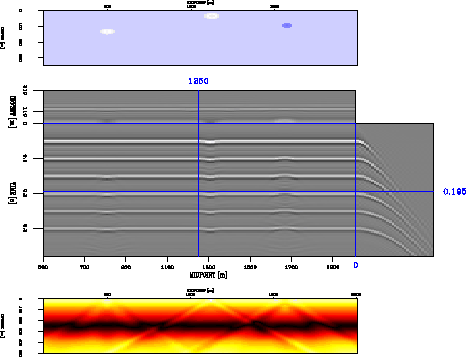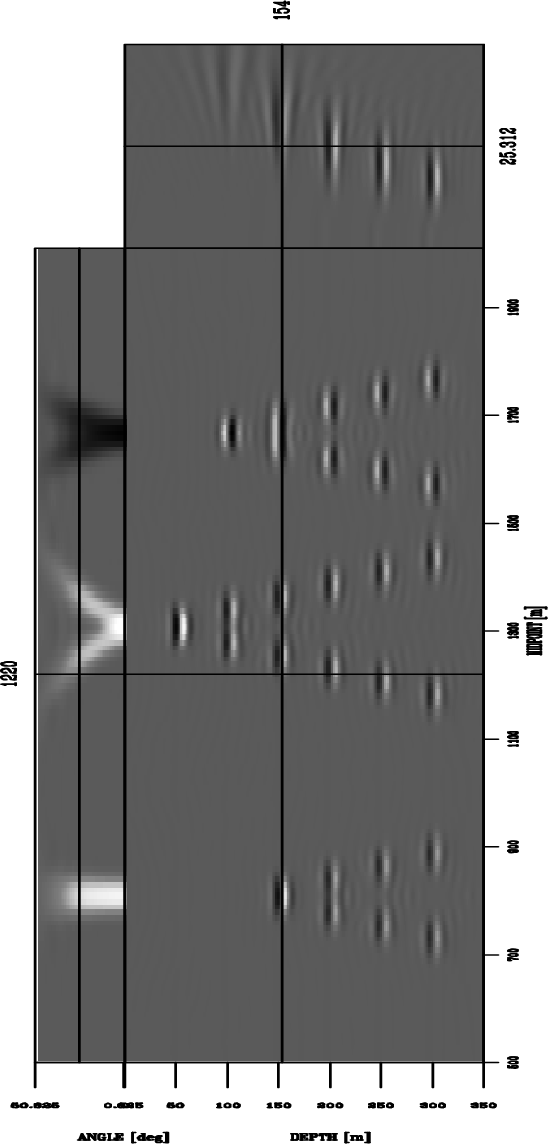




Next: FEAVA detection
Up: Vlad: Focusing-effect AVA
Previous: FEAVA effects in the
Since velocity heterogeneities of the size of those which cause FEAVO
break the high-frequency assumption of the ray theory
Woodward (1990), wavefield extrapolation methods should be
used to migrate and model FEAVO-affected
data. Vlad (2005) has demonstrated qualitatively
that one-way migration methods with the correct velocity model
(containing the FEAVO-causing velocity lenses) eliminate all FEAVA
effects from the image. The same publication shows in the same way
that: (1) only FEAVO effects modeled with two-way schemes
have a microstructure (i.e., width of the bordering shadows) identical
to that of real data, but (2) the
errors introduced by one-way modeling schemes are removed when
migrating with one-way schemes and the correct velocity model.
Thus the numerical experiments from Vlad et al. (2003a), which
show that migration with the correct velocity model removes
FEAVA, keep their validity.
|
Needed: Mathematical proof of the conclusions of
Vlad (2005), and further investigation for cases involving
absorption.
|
Figure ![[*]](http://sepwww.stanford.edu/latex2html/cross_ref_motif.gif) shows the output of modeling FEAVO with a one-way
scheme.
shows the output of modeling FEAVO with a one-way
scheme.
f1
Figure 8 Top: Velocity model with 2000m/s
background and anomalies with peak values, from left to right, of -153m/s,
-188m/s and +231 m/s. Middle: Prestack data generated with one-way
source-receiver upward continuation with two reference
velocities. Bottom: ``Kjartansson V's''. From
Vlad et al. (2003a).




 While the synthetic dataset does feature the small
traveltime anomalies associated with FEAVO, it does not exhibit the
several-fold increase in amplitudes noticed in the real data and which
got FEAVO discovered in the first place Kjartansson (1979); White et al. (1988). The magnitude of the velocity ``lenses'' (10% of the
background) should have been sufficient to have caused it. It is
unclear to what extent the lack of strong amplitude effects is caused
by modeling with a one-way scheme in general (as discussed above) or
by the amplitude characteristics of the particular one-way scheme
employed. FEAVA effects obtained by modeling with a one-way scheme
followed by migrating with the background
velocity (Figure
While the synthetic dataset does feature the small
traveltime anomalies associated with FEAVO, it does not exhibit the
several-fold increase in amplitudes noticed in the real data and which
got FEAVO discovered in the first place Kjartansson (1979); White et al. (1988). The magnitude of the velocity ``lenses'' (10% of the
background) should have been sufficient to have caused it. It is
unclear to what extent the lack of strong amplitude effects is caused
by modeling with a one-way scheme in general (as discussed above) or
by the amplitude characteristics of the particular one-way scheme
employed. FEAVA effects obtained by modeling with a one-way scheme
followed by migrating with the background
velocity (Figure ![[*]](http://sepwww.stanford.edu/latex2html/cross_ref_motif.gif) have neither border shadows/highs as
real data does (Figure
have neither border shadows/highs as
real data does (Figure ![[*]](http://sepwww.stanford.edu/latex2html/cross_ref_motif.gif) ), nor extremely high
amplitudes. Modifications of the downward propagation operators designed
to take into account vertical gradients in velocity
Vlad et al. (2003b) will not result in improvements in this case
because the background velocity is constant. Having correct
amplitudes of FEAVA effects, including their microstructure, is
paramount to the success of any inversion-based removal procedure that
inverts FEAVA into velocity/absorption anomalies, and any such
procedure would need to be tested on a synthetic while being
prototyped.
f6_top
), nor extremely high
amplitudes. Modifications of the downward propagation operators designed
to take into account vertical gradients in velocity
Vlad et al. (2003b) will not result in improvements in this case
because the background velocity is constant. Having correct
amplitudes of FEAVA effects, including their microstructure, is
paramount to the success of any inversion-based removal procedure that
inverts FEAVA into velocity/absorption anomalies, and any such
procedure would need to be tested on a synthetic while being
prototyped.
f6_top
Figure 9 ``Pure'' FEAVA. Obtained by:
(1) migrating the dataset shown in Figure ![[*]](http://sepwww.stanford.edu/latex2html/cross_ref_motif.gif) with the
correct velocity; (2) migrating it with the background velocity; (3)
subtracting the ADCIGs. From Vlad et al. (2003a).
with the
correct velocity; (2) migrating it with the background velocity; (3)
subtracting the ADCIGs. From Vlad et al. (2003a).





|
Needed: Extraction of ``pure'', correct FEAVA effects by
two-way modeling of FEAVA effects followed by two-way migration with
the correct velocity, with the background velocity, and subtraction in
ADCIGs. A comparison with the result of the equivalent one-way flow
(Figure ![[*]](http://sepwww.stanford.edu/latex2html/cross_ref_motif.gif) ) will allow then to assess whether the errors
introduced by the one-way problem are negligible or not. ) will allow then to assess whether the errors
introduced by the one-way problem are negligible or not.
|
Not only primaries are focused by the heterogeneities that caused
FEAVO. Multiples are too. Vlad (2004a) uses numerical
experiments on highly realistic data to present evidence towards the
idea that, unlike FEAVO from primaries, FEAVO from multiples is not
eliminated through simple migration that does not take multiples into
account. It is easy to understand this intuitively: during a migration
designed for primaries, the multiples wavefields do not pass through
the focusing heterogeneities enough times for the focusing to be
undone by the extrapolation operators. Another type of FEAVO that may
not be eliminated by migration is the one caused by absorption. An
absorption compensating-scheme, such as Lu et al. (2004),
would need to be employed to eliminate FEAVO after an absorption model
has been obtained through inversion.





Next: FEAVA detection
Up: Vlad: Focusing-effect AVA
Previous: FEAVA effects in the
Stanford Exploration Project
5/3/2005
![[*]](http://sepwww.stanford.edu/latex2html/cross_ref_motif.gif) shows the output of modeling FEAVO with a one-way
scheme.
shows the output of modeling FEAVO with a one-way
scheme.
![[*]](http://sepwww.stanford.edu/latex2html/cross_ref_motif.gif) shows the output of modeling FEAVO with a one-way
scheme.
shows the output of modeling FEAVO with a one-way
scheme.

![[*]](http://sepwww.stanford.edu/latex2html/cross_ref_motif.gif) have neither border shadows/highs as
real data does (Figure
have neither border shadows/highs as
real data does (Figure ![[*]](http://sepwww.stanford.edu/latex2html/cross_ref_motif.gif) ), nor extremely high
amplitudes. Modifications of the downward propagation operators designed
to take into account vertical gradients in velocity
Vlad et al. (2003b) will not result in improvements in this case
because the background velocity is constant. Having correct
amplitudes of FEAVA effects, including their microstructure, is
paramount to the success of any inversion-based removal procedure that
inverts FEAVA into velocity/absorption anomalies, and any such
procedure would need to be tested on a synthetic while being
prototyped.
), nor extremely high
amplitudes. Modifications of the downward propagation operators designed
to take into account vertical gradients in velocity
Vlad et al. (2003b) will not result in improvements in this case
because the background velocity is constant. Having correct
amplitudes of FEAVA effects, including their microstructure, is
paramount to the success of any inversion-based removal procedure that
inverts FEAVA into velocity/absorption anomalies, and any such
procedure would need to be tested on a synthetic while being
prototyped.

![[*]](http://sepwww.stanford.edu/latex2html/cross_ref_motif.gif) with the
correct velocity; (2) migrating it with the background velocity; (3)
subtracting the ADCIGs. From Vlad et al. (2003a).
with the
correct velocity; (2) migrating it with the background velocity; (3)
subtracting the ADCIGs. From Vlad et al. (2003a).